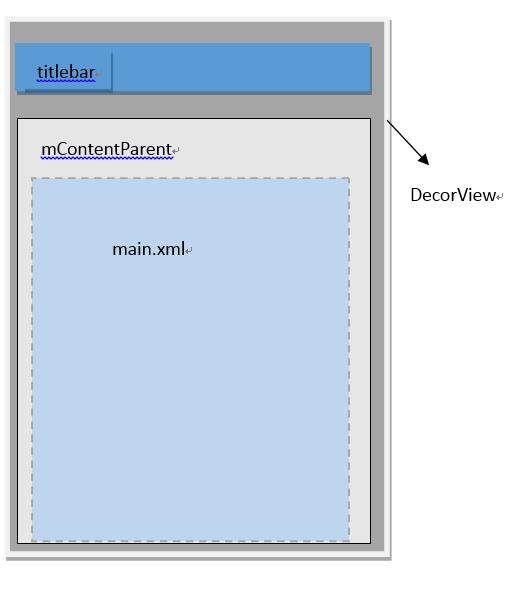前言
对于Android开发者来说,View无疑是开发中经常接触的,包括它的事件分发机制、测量、布局、绘制流程等,如果要自定义一个View,那么应该对以上流程有所了解、研究。本系列文章将会为大家带来View的工作流程详细解析。在深入接触View的测量、布局、绘制这三个流程之前,我们从Activity入手,看看从Activity创建后到View的正式工作之前,所要经历的步骤。以下源码均取自Android API 21。
从setContentView说起
一般地,我们在Activity中,会在onCreate()方法中写下这样一句:
- 1
- 1
显然,这是为activity设置一个我们定义好的main.xml布局,我们跟踪一下源码,看看这个方法是怎样做的,Activity#setContentView:
- 1
- 2
- 3
- 4
- 5
- 6
- 7
- 8
- 1
- 2
- 3
- 4
- 5
- 6
- 7
- 8
从上面看出,里面调用了mWindow的setContentView方法,那么这个“mWindow”是何方神圣呢?尝试追踪一下源码,发现mWindow是Window类型的,但是它是一个抽象类,setContentView也是抽象方法,所以我们要找到Window类的实现类才行。我们在Activity中查找一下mWindow在哪里被赋值了,可以发现它在Activity#attach方法中有如下实现:
- 1
- 2
- 3
- 4
- 5
- 6
- 7
- 8
- 9
- 10
- 1
- 2
- 3
- 4
- 5
- 6
- 7
- 8
- 9
- 10
我们只看关键部分,这里实例化了PhoneWindow类,由此得知,PhoneWindow是Window的实现类,那么我们在PhoneWindow类里面找到它的setContentView方法,看看它又实现了什么,PhoneWindow#setContentView:
- 1
- 2
- 3
- 4
- 5
- 6
- 7
- 8
- 9
- 10
- 11
- 12
- 13
- 14
- 15
- 16
- 17
- 18
- 19
- 20
- 21
- 22
- 23
- 1
- 2
- 3
- 4
- 5
- 6
- 7
- 8
- 9
- 10
- 11
- 12
- 13
- 14
- 15
- 16
- 17
- 18
- 19
- 20
- 21
- 22
- 23
首先判断了mContentParent是否为null,如果为空则执行installDecor()方法,那么这个mContentParent又是什么呢?我们看一下它的注释:
- 1
- 2
- 3
- 1
- 2
- 3
它是一个ViewGroup类型,结合②号代码处,可以得知,这个mContentParent是我们设置的布局(即main.xml)的父布局。注释还提到了,这个mContentParent是mDecor本身或者是mDecor的一个子元素,这句话什么意思呢?这里先留一个疑问,下面会解释。
这里先梳理一下以上的内容:Activity通过PhoneWindow的setContentView方法来设置布局,而设置布局之前,会先判断是否存在mContentParent,而我们设置的布局文件则是mContentParent的子元素。
创建DecorView
接着上面提到的installDecor()方法,我们看看它的源码,PhoneWindow#installDecor:
- 1
- 2
- 3
- 4
- 5
- 6
- 7
- 8
- 9
- 10
- 11
- 12
- 13
- 14
- 15
- 1
- 2
- 3
- 4
- 5
- 6
- 7
- 8
- 9
- 10
- 11
- 12
- 13
- 14
- 15
首先,会执行①号代码,调用PhoneWindow#generateDecor方法:
- 1
- 2
- 3
- 1
- 2
- 3
可以看出,这里实例化了DecorView,而DecorView则是PhoneWindow类的一个内部类,继承于FrameLayout,由此可知它也是一个ViewGroup。
那么,DecroView到底充当了什么样的角色呢?
其实,DecorView是整个ViewTree的最顶层View,它是一个FrameLayout布局,代表了整个应用的界面。在该布局下面,有标题view和内容view这两个子元素,而内容view则是上面提到的mContentParent。我们接着看②号代码,PhoneWindow#generateLayout方法
- 1
- 2
- 3
- 4
- 5
- 6
- 7
- 8
- 9
- 10
- 11
- 12
- 13
- 14
- 15
- 16
- 17
- 18
- 19
- 20
- 21
- 22
- 23
- 24
- 25
- 26
- 27
- 28
- 29
- 30
- 31
- 32
- 33
- 34
- 35
- 36
- 37
- 38
- 39
- 40
- 41
- 42
- 43
- 44
- 45
- 46
- 47
- 48
- 49
- 50
- 51
- 52
- 53
- 54
- 55
- 1
- 2
- 3
- 4
- 5
- 6
- 7
- 8
- 9
- 10
- 11
- 12
- 13
- 14
- 15
- 16
- 17
- 18
- 19
- 20
- 21
- 22
- 23
- 24
- 25
- 26
- 27
- 28
- 29
- 30
- 31
- 32
- 33
- 34
- 35
- 36
- 37
- 38
- 39
- 40
- 41
- 42
- 43
- 44
- 45
- 46
- 47
- 48
- 49
- 50
- 51
- 52
- 53
- 54
- 55
由以上代码可以看出,该方法还是做了相当多的工作的,首先根据设置的主题样式来设置DecorView的风格,比如说有没有titlebar之类的,接着为DecorView添加子View,而这里的子View则是上面提到的mContentParent,如果上面设置了FEATURE_NO_ACTIONBAR,那么DecorView就只有mContentParent一个子View,这也解释了上面的疑问:mContentParent是DecorView本身或者是DecorView的一个子元素。
用一幅图来表示DecorView的结构如下:
小结:DecorView是顶级View,内部有titlebar和contentParent两个子元素,contentParent的id是content,而我们设置的main.xml布局则是contentParent里面的一个子元素。
在DecorView创建完毕后,让我们回到PhoneWindow#setContentView方法,直接看②号代码: mLayoutInflater.inflate(layoutResID, mContentParent);这里加载了我们设置的main.xml布局文件,并且设置mContentParent为main.xml的父布局,至于它怎么加载的,这里就不展开来说了。
到目前为止,通过setContentView方法,创建了DecorView和加载了我们提供的布局,但是这时,我们的View还是不可见的,因为我们仅仅是加载了布局,并没有对View进行任何的测量、布局、绘制工作。在View进行测量流程之前,还要进行一个步骤,那就是把DecorView添加至window中,然后经过一系列过程触发ViewRootImpl#performTraversals方法,在该方法内部会正式开始测量、布局、绘制这三大流程。至于该一系列过程是怎样的,因为涉及到了很多机制,这里简单说明一下:
将DecorView添加至Window
每一个Activity组件都有一个关联的Window对象,用来描述一个应用程序窗口。每一个应用程序窗口内部又包含有一个View对象,用来描述应用程序窗口的视图。上文分析了创建DecorView的过程,现在则要把DecorView添加到Window对象中。而要了解这个过程,我们首先要简单先了解一下Activity的创建过程:
首先,在ActivityThread#handleLaunchActivity中启动Activity,在这里面会调用到Activity#onCreate方法,从而完成上面所述的DecorView创建动作,当onCreate()方法执行完毕,在handleLaunchActivity方法会继续调用到ActivityThread#handleResumeActivity方法,我们看看这个方法的源码:
- 1
- 2
- 3
- 4
- 5
- 6
- 7
- 8
- 9
- 10
- 11
- 12
- 13
- 14
- 15
- 16
- 17
- 18
- 19
- 20
- 21
- 22
- 23
- 24
- 25
- 1
- 2
- 3
- 4
- 5
- 6
- 7
- 8
- 9
- 10
- 11
- 12
- 13
- 14
- 15
- 16
- 17
- 18
- 19
- 20
- 21
- 22
- 23
- 24
- 25
在该方法内部,获取该activity所关联的window对象,DecorView对象,以及windowManager对象,而WindowManager是抽象类,它的实现类是WindowManagerImpl,所以后面调用的是WindowManagerImpl#addView方法,我们看看源码:
- 1
- 2
- 3
- 4
- 5
- 6
- 7
- 8
- 1
- 2
- 3
- 4
- 5
- 6
- 7
- 8
接着调用了mGlobal的成员函数,而mGlobal则是WindowManagerGlobal的一个实例,那么我们接着看WindowManagerGlobal#addView方法:
- 1
- 2
- 3
- 4
- 5
- 6
- 7
- 8
- 9
- 10
- 11
- 12
- 13
- 14
- 15
- 16
- 17
- 18
- 19
- 20
- 21
- 22
- 23
- 24
- 25
- 26
- 27
- 28
- 29
- 30
- 31
- 32
- 33
- 1
- 2
- 3
- 4
- 5
- 6
- 7
- 8
- 9
- 10
- 11
- 12
- 13
- 14
- 15
- 16
- 17
- 18
- 19
- 20
- 21
- 22
- 23
- 24
- 25
- 26
- 27
- 28
- 29
- 30
- 31
- 32
- 33
先看①号代码处,实例化了ViewRootImpl类,接着,在②号代码处,调用ViewRootImpl#setView方法,并把DecorView作为参数传递进去,在这个方法内部,会通过跨进程的方式向WMS(WindowManagerService)发起一个调用,从而将DecorView最终添加到Window上,在这个过程中,ViewRootImpl、DecorView和WMS会彼此关联,至于详细过程这里不展开来说了。
最后通过WMS调用ViewRootImpl#performTraverals方法开始View的测量、布局、绘制流程,这三大流程在下文会详细讲述,谢谢大家的阅读。























 1236
1236

 被折叠的 条评论
为什么被折叠?
被折叠的 条评论
为什么被折叠?








